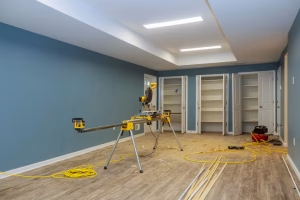Financing a basement renovation is one of the most important decisions Edmonton homeowners face when converting underused space into a functional living area, rental suite, or home office. Whether you’re adding a secondary suite for rental income, finishing a family room, or upgrading for aging-in-place features, understanding your financing options helps you choose a path that fits your goals and your household finances.
This guide walks through practical, locally relevant financing options for basement renovations in Edmonton, explains the pros and cons of each approach, and highlights steps to prepare for financing conversations with lenders and contractors. Throughout, we include real-world examples, local context for Edmonton homeowners, and trusted resources to help you make an informed choice. We also explain how Steadfast Constructions Ltd. can support planning, permitting, and contractor-backed financing conversations.
Why financing matters for basement renovations in Edmonton
Basement renovations can increase usable space and home value, but they require careful planning and financing. Recent national indicators show that renovation prices and consumer expectations are evolving — renovation price indices have shown modest increases in recent quarters in Canada, highlighting ongoing cost pressures in the construction sector. Statistics Canada
At the same time, federal initiatives to support secondary suites signal growing policy interest in enabling homeowners to add rental units and increase housing supply, a development directly relevant to Edmonton homeowners considering a legal secondary suite. For instance, the federal government announced measures to expand loan support for secondary suites to encourage conversions. Canada.ca
Taken together, these trends mean homeowners should evaluate financing early, compare options, and involve a trusted local contractor such as Steadfast Constructions Ltd. to align scope, permits, and realistic timelines before applying for loans.
Common financing options for basement renovations
Below are the primary financing routes Edmonton homeowners typically consider. Each option includes practical considerations so you can match the approach to your project and personal finances.
1. Personal savings and emergency reserves
Using savings avoids interest and approvals, providing the simplest path. If you have readily available funds, paying directly keeps the project flexible and reduces financing complexity. However, dipping into emergency reserves can create risk; discuss with your financial advisor before committing large sums.
2. Home Equity Line of Credit (HELOC)
A HELOC lets homeowners borrow against the available equity in their property on a revolving credit line. HELOCs offer flexibility; you can draw funds as needed during construction and repay on a flexible schedule. They are commonly used for renovations where the scope can change.
Considerations for Edmonton homeowners:
- HELOC interest rates are variable, so budget for potential rate changes.
- Lenders will typically require an appraisal and proof of income.
- Ensure your contractor provides staged invoices that align with draws.
3. Mortgage refinance / cash-out refinance
Refinancing the mortgage to access equity can secure a lower fixed rate for renovation funds. This option can make sense for larger projects where locking in a stable payment is desirable. Refinancing comes with fees and closing costs, and it changes your mortgage profile. Discuss the long-term mortgage implications with a mortgage specialist.
4. Home renovation loans and secured home equity loans
Some lenders offer dedicated renovation loans or secured loans based on home equity with fixed repayment terms. These products blend the predictability of a fixed loan with the lower rates of secured borrowing. For homeowners planning a secondary suite or a complete basement finish, these loans can offer clarity on monthly payments.
CMHC and other housing authorities provide guidance on financing options homeowners should review before choosing a lender. cmhc-schl.gc.ca
5. Government and municipal programs
Federal and provincial programs sometimes offer loans or incentives for specific renovation types, especially conversions that increase housing supply (for example, legal secondary suites). In late 2024, federal measures expanding support for secondary suites were announced, which can directly benefit Edmonton homeowners considering basement conversions. Check program start dates and eligibility carefully. Canada.ca
Locally, the City of Edmonton has permit and code requirements for secondary suites and other significant basement work; confirm permit pathways early with the city and your contractor.
6. Contractor-backed financing
Some contractors partner with finance providers to offer project financing. These arrangements can range from short-term installment plans to longer-term loans arranged through third-party lenders. Steadfast Constructions Ltd. works with reputable local lenders and financing partners to help clients explore contractor-backed options when a homeowner prefers a single point of contact for construction and financing logistics.
7. Personal loans or lines of credit
Unsecured personal loans or lines of credit avoid using home equity but usually carry higher interest rates. These may suit smaller basement upgrades rather than full conversions.
8. Homeowner grant or rebate programs
Programs tied to energy efficiency or accessibility upgrades can sometimes offset part of the renovation costs, for example, incentives for energy-efficient windows, insulation, or heat pumps. Check federal/provincial program specifics and deadlines. The Canada Greener Homes program and other CMHC resources can point you to relevant options. cmhc-schl.gc.ca
Matching options to basement project types
Different basement projects suggest different financing strategies:
- Minor basement finish (insulation, drywall, lighting): Personal savings, personal loan, or small HELOC draw.
- Full legal secondary suite conversion (separate entrance, kitchen, bathroom): Consider secured home equity loan or government suite loan opportunities; involve a contractor early to estimate scope and required permits.
- Accessibility/adaptations (wider doorways, accessible bathroom): Check for local or provincial grant programs and weigh contractor-backed financing if needed.
- Multi-stage projects (phase-by-phase finish): HELOC or staged draws work well to match payments with construction phases.
How to prepare before you apply for financing
Good preparation increases approval chances and helps ensure the loan amount matches real needs.
- Get a detailed scope and phased work plan from your contractor, Steadfast Constructions Ltd. provides scope documents that outline trade costs, timelines, and permit requirements.
- Obtain permits and verify code compliance expectations with the City of Edmonton.
- Collect financial documents lenders request: proof of income, recent tax documents, and a mortgage statement if applicable.
- Ask your contractor for staged invoicing to match draws if using HELOC or contractor-backed payments.
- Compare lender offers, and look beyond interest rates: fees, prepayment options, and penalty terms matter.
Real-world Edmonton example
Sarah and James, in the Bonnie Doon neighbourhood, wanted a legal basement suite to generate rental income and age-in-place options for visiting parents. They worked with Steadfast Constructions Ltd. to design a compliant secondary suite, secure required permits, and stage construction. For financing, they combined a modest HELOC for initial framing and a secured home renovation loan for permanent fixtures and finishing. Their lender required a contractor scope and city permit before final approval. Having Steadfast handle the permit process helped speed the loan confirmation. This example illustrates how integrated contractor support and early planning smooth financing approvals and project delivery.
“Start the conversation early with your contractor and lender. A clear scope and permit-ready plan change the lending experience from guesswork to certainty.”
— Sarah Mitchell, Senior Project Manager, Steadfast Constructions Ltd.
Questions lenders will ask and how to answer them.
Lenders typically focus on these points:
- Purpose of the loan: Be specific, finishing a basement into a rental suite or family living space.
- Project scope and timeline: Provide contractor estimates and permit statuses.
- Repayment strategy: Explain whether you’ll use rental income, savings, or existing income.
- Security: If using home equity, be prepared to show your mortgage balance and property valuation.
Providing detailed documentation early speeds approval and reduces surprises.
Risks and ways to mitigate them
Financing a renovation introduces financial and construction risks. Key mitigations include:
- Contingency planning: Budget time and a small contingency for unforeseen issues (no numeric amounts stated here).
- Fixed-price contracts where feasible: Steadfast Constructions Ltd. offers clear contract terms and change-order processes to minimize scope creep.
- Confirm permit and insurance requirements: Unpermitted work can complicate resale and insurance; always secure the right permits.
- Plan for temporary displacement: Some basement conversions require short-term living adjustments.
How Steadfast Constructions Ltd. supports financing and project readiness
Steadfast Constructions Ltd. helps Edmonton homeowners in three practical ways:
- Design-to-permit packages: we prepare permit-ready drawings and scope documents that lenders prefer to see.
- Lender introductions: through established local lender relationships, we can provide recommended financing partners to clients who request help.
- Project phasing and staged invoicing: we coordinate draws and invoices to match HELOC or lender milestone payments, smoothing cash flow for homeowners.
Our Edmonton-based team understands local code requirements and common issues in basement renovations, which reduces lender friction and shortens approval timelines for many homeowners.
Choosing between options
Use this checklist to choose a financing approach that fits your goals:
- Is the basement a long-term investment (rental suite / aging-in-place)? If yes, consider secured financing that spreads payments over time.
- Do you prefer predictability? Fixed-rate renovation loans or mortgage refinancing can provide stability.
- Will you need flexibility for scope changes? HELOCs and staged draws offer agility.
- Do you want to avoid using home equity? Personal loans or contractor financing may be alternatives, but compare rates carefully.
- Have you verified permits and compliance with City of Edmonton requirements? This is essential before lender approval.
Making the financing conversation work
- Contact Steadfast Constructions Ltd. for a complimentary project consultation and to obtain a permit-ready scope.
- Collect and organize your financial documents and property information.
- Speak with at least two lenders or mortgage brokers about renovation-specific products and compare terms.
- Confirm the permit pathway with the City of Edmonton and align timelines with your preferred lender.
Steadfast can prepare the technical and scope documents lenders typically require, and can introduce homeowners to local mortgage brokers and financing partners when requested.
Conclusion
Choosing financing for basement renovations in Edmonton requires matching the project scope to the right financial product, preparing the documentation lenders expect, and partnering with a contractor who understands permitting and lender requirements. Many Edmonton homeowners find the best outcomes when they combine contractor expertise with clear financing plans, particularly for projects like legal secondary suites that involve permits and potential rental income.
If you’re planning a basement renovation in Edmonton, Steadfast Constructions Ltd. can help with permit-ready scopes, trusted lender introductions, and project phasing that aligns with financing draws. Contact Steadfast Constructions Ltd. to schedule a consultation and get a clear, lender-ready plan for your basement project.
Ready to explore financing options and start your basement renovation? Reach out to Steadfast Constructions Ltd. for a consultation and a tailored plan that fits your goals and local permitting requirements.
Frequently Asked Questions (FAQs)
Q1: What financing options are best for finishing a basement into a legal secondary suite in Edmonton?
A1: Common options include secured home equity loans, HELOCs, mortgage refinancing (cash-out), and government-backed secondary suite loan programs where available. Lenders typically want a permit-ready scope and proof of compliance with the City of Edmonton rules before approving financing.
Q2: Can rental income from a finished basement help secure financing?
A2: Yes. Many lenders consider projected rental income when evaluating renovation financing for a legal secondary suite, but they usually require realistic rental estimates, a permit, and a contractor scope to support those projections.
Q3: Does Steadfast Constructions Ltd. help with lender-ready documents and permits?
A3: Yes. Steadfast provides design-to-permit packages, detailed scopes of work, and staged invoicing that lenders commonly require for renovation financing.
Q4: Are there government programs to help finance basement conversions in Canada?
A4: Federal and provincial initiatives occasionally provide loan support or incentives for secondary suites and energy-efficient upgrades. Homeowners should check current programs and eligibility; federal announcements in late 2024 expanded support for secondary suite loans.
Q5: What should I prepare before applying for a renovation loan in Edmonton?
A5: Prepare a detailed scope of work from your contractor, confirm permit requirements with the City of Edmonton, and gather financial documents (proof of income, mortgage statements). Having a contractor like Steadfast produce a permit-ready plan significantly improves lender confidence and speeds approvals.







